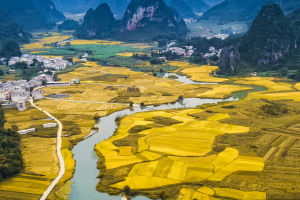Mount Fuji is one of Japan's most iconic landmarks and one of the most famous volcanoes in the world. An active stratovolcano, it is located in the central part of the Japanese island of Honshu, about 100 kilometers from Tokyo, and at 3,776 meters (12,389 ft), it is the highest mountain in Japan.
Mount Fuji is known for its distinctive conical appearance, which was formed by volcanic eruptions. Its beauty and magnificence attract tourists and mountaineering enthusiasts from all over the world. Every summer, tens of thousands of people challenge the summit of Mount Fuji and experience an unforgettable mountaineering trip.
A journey to the summit of Mt. Fuji can begin with five different climbing routes, each offering different scenery and challenges. Climbers can enjoy the majestic sunrise of Mt. Fuji and stunning views of the surroundings. There is Mount Fuji Shrine on the top of the mountain, which is a holy place to pray for luck and blessing.
Besides climbing, there are many other activities and attractions around Mount Fuji. One of the most popular tourist destinations in the surrounding area is the Fuji Five Lakes, which include Lake Kawaguchi, Lake Sai, Lake Shoji, Lake Motosu, and Lake Mishima. The lakes offer recreational activities such as boating, fishing, and lakeside walks, as well as stunning views of Mt. Fuji's autumn foliage in the fall.
In addition, the hot springs around Mt. Fuji are also popular among tourists. Soaking in a hot spring is a great way to relax and rejuvenate after a mountain hike. The nearby hot spring resorts provide a variety of facilities and services for tourists to enjoy spa treatments in a comfortable environment.
Mount Fuji holds an important place in Japanese culture and art. It is the inspiration for many traditional paintings, poems, and literature, and is regarded as a symbol of Japanese spirituality and aesthetics.
Overall, Mount Fuji is known for its breathtaking views, challenging climbs, and rich and varied tourist activities. As one of the symbols of Japan, it attracts tourists from all over the world and becomes an unforgettable travel destination. Whether gazing at its majestic vistas from a distance or climbing its peak in person, Mt. Fuji can leave deep impressions and treasured memories.
Mount Fuji is not only a natural wonder, but also a symbol of Japanese culture and history. In traditional Japanese art and literature, Mount Fuji is often depicted as a source of beauty, majesty, and inspiration. Many artists and literati have found inspiration and enlightenment in front of Mount Fuji.
Climbing to the top of Mt. Fuji is a feat that many people dream of. Although the challenge is daunting, the sense of accomplishment after successfully reaching the top is unparalleled. Every summer, thousands of climbers from all over the world gather at the foot of Mount Fuji to take on this exciting challenge. They feel the physical and mental struggle and growth during the climbing process while enjoying the magnificent natural scenery and charming sunrise.
The sights and activities around Mt. Fuji also attract tourists. The Fuji Five Lakes area is a pleasant vacation destination, offering numerous opportunities for outdoor activities such as boating, fishing, hiking, and biking. And along the foothills of Mt. Fuji, there are many hot springs and hot spring resorts where visitors can relax and enjoy the unique Japanese hot spring culture.
Whether looking for thrill and adventure, or tranquility and relaxation, Mount Fuji has something for everyone. With its magnificent natural landscape, rich cultural heritage, and vibrant mountaineering culture, it has become one of the treasures of Japanese tourism. For tourists, Mt. Fuji is an excellent opportunity to learn more about and appreciate the beauty of Japan's nature and culture.


